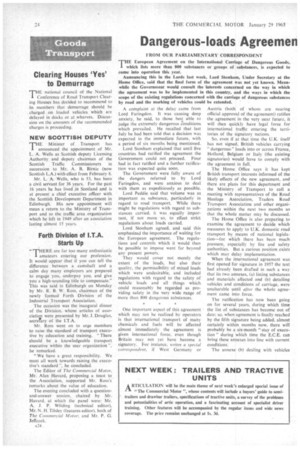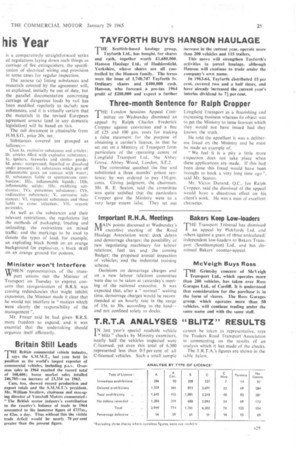Dangerous-loads Agreemen his Year
Page 26

Page 27

If you've noticed an error in this article please click here to report it so we can fix it.
FROM OUR PARLIAMENTARY CORRESPONDENT THE European Agreement on the International Carriage of Dangerous Goods, I. which lists more than 800 substances or groups of substances, is expected to come into operation this year.
Announcing this in the Lords last week, Lord Stonham, Under Secretary at the Horne Office, said that the final form of the agreement was not yet known. Meanwhile the Government would consult the interests concerned on the way in which the agreement was to be implemented in this country, and the ways in which the scope of the existing regulations concerned with the carriage of dangerous substances by road and the marking of vehicles could be extended.
A complaint at the delay came from Lord Faringdon. It was causing deep anxiety, he said, to those best able to judge the extremely dangerous conditions which prevailed. He recalled that last July he had been told that a decision was expected in the immediate future, with a period of six months being mentioned.
Lord Stonham explained that until five countries had ratified the agreement the Government could not proceed. Four had in fact ratified and a further ratification was expected quite soon.
The Government were fully aware of the dangers referred to by Lord Faringdon, and were anxious to deal with them as expeditiously as possible.
Lord Peddie said that volume was as important as substance, particularly in regard to road transport. While there might be regulations with regard to substances carried, it was equally important, if not more so, to effect strict regulations about loads carried.
Lord Stonham agreed, and said this emphasized the importance of waiting for the European agreement. The regulations and controls which it would then be possible to impose went far beyond any present powers.
They would cover not merely the extent of the loads, but also their quality, the permissibility of mixed loads which were undesirable, and included regulations with regard to the safety of vehicle loads and all things which could reasonably be regarded as providing safety in the very wide range of more than 800 dangerous substances.
One important aspect of this agreement which may not he realized by operators is that international transport of many chemicals and fuels will be affected almost immediately the agreement is given international force, even though Britain may not yet have become a signatory. For instance, writes a special correspondent, if West Germany or
Austria (both of whom are nearing official approval of the agreement) ratifies the agreement in the very near future, it will then quickly have legal force for international traffic entering the territories of the signatory nations.
So, even if at that time the U.K. itself has not signed, British vehicles carrying "dangerous." loads into or across France, Holland, Belgium or Italy (the existing signatories) would have to comply with the agreement in full.
The Home Office says it has kept British transport interests informed of the likely effects of the new agreement, and there are plans for this department and the Ministry of Transport to call a meeting with representatives of the Road Haulage Association, Traders Road Transport Association and other organizations within the next two months so that the whole matter may be discussed.
The Home Office is also preparing to examine the agreement to decide which measures to apply to U.K. domestic road transport by means of national legislation—for which there has been much pressure, especially by fire and safety authorities. But a curious position exists which may delay implementation.
When the international agreement was first opened for signature in 1957 the text had already been drafted in such a way that its two annexes, (a) listing substances and materials affected and (b) detailing vehicles and conditions of carriage, were unalterable until after the whole agreement came into force.
The ratification has now been going on for several years, during which time the list of substances has become out of date: so. when agreement is finally reached by the fifth signature being added, almost certainly within months now, there will probably be a six-month "stay of execution" during which time the E.C.E. can bring these annexes into line with current conditions.
The annexe (b) dealing with vehicles is a comparatively straightforward series of regulations laying down such things as carriage of fire extinguishers, the specification of electrical wiring and provision in some cases for regular inspection.
The annexe (a) listing substances and materials covered by the agreement will, as explained, initially be out of date, but the parallel documentation concgrning carriage of dangerous loads by rail has been modified regularly to include new substances, and it is virtually certain that the materials in the revised European agreement annexe (and in any domestic legislation) will be based on this.
The rail document is obtainable from H.M.S.O., price 20s. net.
Substances covered are grouped as follows:— Class la. explosive substances and articles; Ib, articles filled with explosive substances; lc, igniters, fireworks and similar goods; Id, gases: compressed. liquefied or dissolved under pressure; le, substances which give off inflammable gases on contact with water; II, substances liable to spontaneous combustion; Illa, inflammable liquids; Illb, inflammable solids; lite, oxidizing substances; IVa, poisonous substances; IVb, radioactive substances; V, corrosive substances; VI, repugnant substances and those liable to cause infection ; VII, organic peroxides.
As well as the substances and their relevant restrictions, the regulations list the methods of packaging, loading and unloading; the restrictions on mixed traffic; and the markings to be used to denote the types of load, for example, an exploding black bomb on an orange background for explosives, a black skull on an orange ground for poisons.
Minister won't Interfere WHEN representatives of the transport unions met the Minister of Transport on Tuesday to express concern that reorganization of B.R.S. was causing redundancies that might inhibit expansion, the Minister made it clear that he would not interfere in "matters which were clearly the responsibility of the management ".
Mr. Fraser said he had given B.R.S. more freedom to expand, and it was essential that the undertaking should organize itself efficiently.




















































































































